Share this
What is a LAN Port (Local Area Network)?
by Brett Daniel on Apr 15, 2020 1:15:00 PM
Consumer: What in the world is going on with this phone jack on the back of my PC? I've been trying to connect the phone cable to it but with no luck. I've got to get connected today!
Trenton Systems: Hey, no worries! That's actually a LAN port, and you need an Ethernet cable, not a phone cable, to connect to the internet. The phone jack and LAN port are similar in appearance but different in purpose!
Consumer: Oh! Well, that's good to know! Say, do you mind telling me exactly what a LAN port is and how it works?
Trenton Systems: Sure thing!
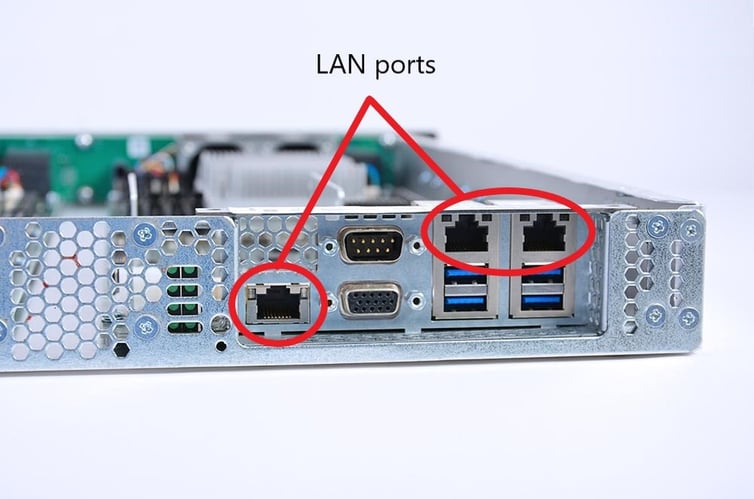
Photo: Three LAN ports on the back of a Trenton Systems 1000 Series Rugged Server. Our standard input/output interface can be customized to fit your specific program or application.
What is a LAN port?
A LAN port, also known as a network port or network connection, is a socket used to connect computers, servers, video game consoles, and other devices to the internet. They’re typically located on the back of both computers and network devices and are used solely to establish a wired, as opposed to a wireless, internet connection.
What does LAN stand for?
LAN stands for Local Area Network. A LAN is just a collection of devices connected over a short distance, compared to Wide Area Networks (WANs) and Metropolitan Area Networks (MANs), which connect devices located considerable distances from each other.
The term LAN port gets its name from the port's use in LANs, such as home networks, school, and office building networks.
A LAN port is also known as an Ethernet port. Both terms refer to exactly the same socket on computers, servers, modems, Wi-Fi routers, switches, and other network devices.
The term Ethernet port gets its name from the Ethernet protocol, developed by the Institute of Electrical and Electronics Engineers.
Photo: Comparison of phone jacks (left) and LAN ports. They look very similar, but they each serve a distinct purpose.
What does a LAN port look like?
LAN ports are about the size of your thumb. They resemble those old landline telephone jacks, but they’re much wider. This is because LAN ports contain eight pins, compared to the phone jack’s four or six.
You could think of the LAN port as the beefy big brother of the telephone jack, but don’t confuse the two, as they each serve a distinct purpose.
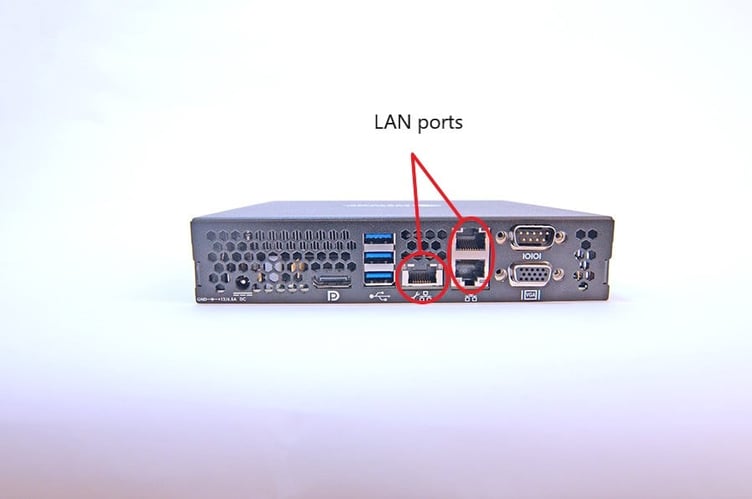
Photo: Three LAN ports on the back of Trenton Systems' ION Mini PC.
Where are LAN ports located?
LAN ports are found on modems, routers, servers, desktop computer towers, mini PCs, laptops, network switches, video game consoles, and even smart TVs.
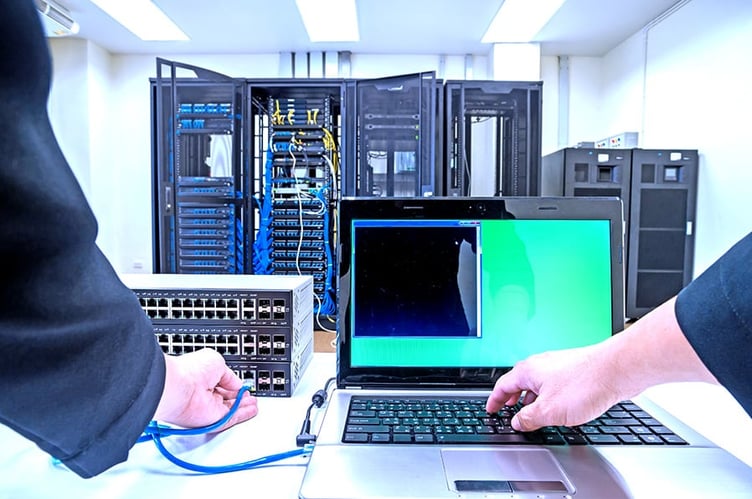
Photo: An Ethernet cable being inserted into a LAN port on a network switch
How does a LAN port work?
For a LAN port to serve its intended purpose, it needs an Ethernet cable and two Ethernet-compatible devices. To establish a connection, plug the Ethernet cable into the LAN port on the device that’s connected to the internet, such as a modem, router, or modem-router combo, and connect the cable to the computer, game console, or other devices at the opposite end.
Voila! You’ve just established an internet connection using a LAN port and Ethernet cable.
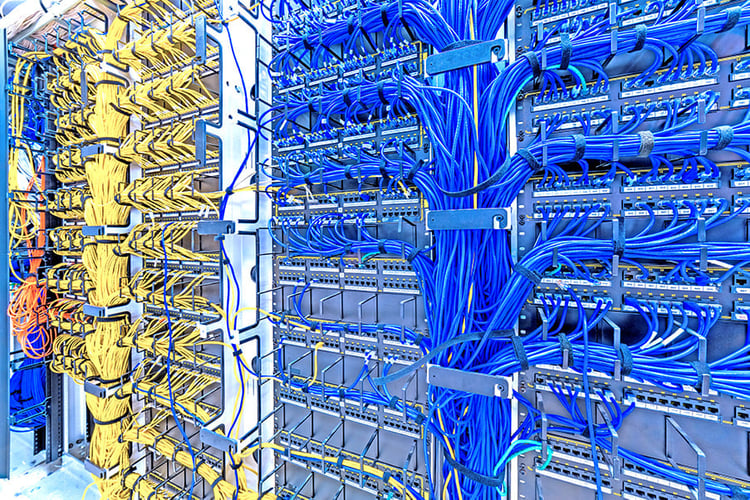
Photo: Cat 5e Ethernet cables plugged into LAN ports in a large data center
What is a LAN cable?
LAN cables, more often referred to as Ethernet cables, are comprised of copper wiring and come in a few different categories, the most common of which are Cat 5e and Cat 6. The cables terminate with an RJ45, or registered jack 45, connector. The RJ45 connector is just the piece at the end of the Ethernet cable that's inserted into the LAN port.
Fun fact: The RJ45 connector's widespread use in LANs is why the LAN port is sometimes referred to as an RJ45 port or an RJ45 Ethernet socket. Who knew that LAN ports could have so many different names?
Photo: An internal comparison of Cat 5e and Cat 6 cables. Note the spline at the center of the Cat 6. This piece separates the wire pairs to help reduce crosstalk. Credit: Fiber Optical Networking
Okay, back to cabling. The category of Ethernet cable you use to connect devices will depend on the data transfer rate capabilities of your network. The lower categories, Categories 3-5, support transfer rates of between 10 Mbps and 100 Mbps at a maximum bandwidth of 100 MHz. These have virtually fallen out of use due to advancements in data transfer rate and bandwidth.
The Cat 5e cable, on the other hand, supports transfer rates of up to 1 Gbps at 100 MHz. A Cat 6 cable supports the same transfer rate as the Cat 5e cable but has a higher maximum bandwidth, at 250 MHz. Cat 6a cables and newer support transfer rates of up to 10 Gbps and between 500 and 1,000 MHz. The Cat 5e, 6, and 6a cables, in particular, are the major players in today's computer networking arena.
| Cable | Maximum Transfer Rate | Maximum Bandwidth |
| Cat 5e | 1 Gbps | 100 MHz |
| Cat 6 | 1 Gbps | 250 MHz |
| Cat 6a | 10 Gbps | 500 MHz |
| Cat 7 | 10 Gbps | 600 MHz |
Table: Comparison of Cat 5e Ethernet cables and higher. Also note the positive relationship between the cable category, maximum transfer rate, and maximum bandwidth. The higher the data transfer rate, the more data that can be transferred in a given amount of time.
Keep in mind that these cables shouldn’t exceed 100 meters, or else the data transfer rate will decrease. You can use an internet speed test to determine the data transfer rate of your network, and this will help you choose the right Ethernet cable for your application. Generally, it’s best to go with a Cat 5e cable or newer, as gigabit internet service is becoming more and more commonplace.
Photo: LAN ports (left) vs. the SFP port and transceiver
How does a LAN port differ from an SFP port?
There are a couple of key differences between LAN ports and SFP ports, both of which are found on computers and network devices.
The most obvious difference is that SFP (small form-factor pluggable) ports require an SFP transceiver to establish a connection, rather than just an Ethernet cable.
Another difference is distance. Due to their copper wiring, Ethernet cables can only extend so far before performance decline occurs. An SFP port, on the other hand, allows for the use of fiber optic cables, which can extend further without experiencing a significant decline in data transfer rate.
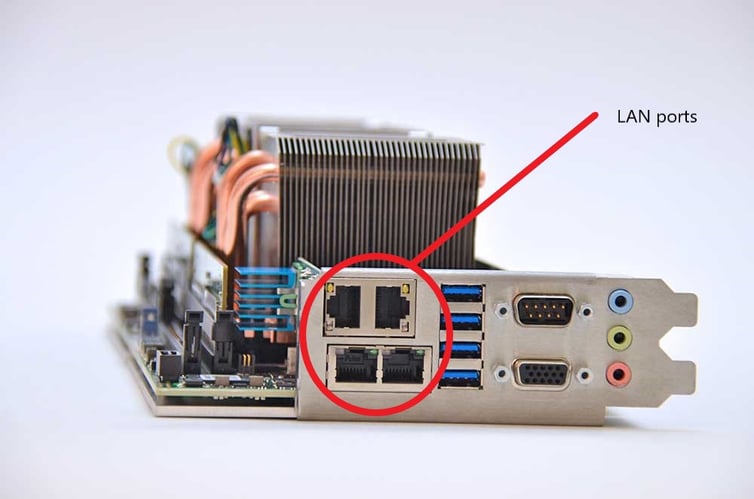
Photo: Four LAN ports on a SEP8253 processor board, used in Trenton Systems' rugged servers
Which Trenton products include a LAN port?
Trenton Systems’ rugged servers, from the 1,000 to the 5,000 series, are equipped with two 1GbE and two 10Gbe LAN ports, as well as IPMI (Intelligent Platform Management Interface) to ensure protection of the ports.
What are 1GbE and 10Gbe, you might ask?
They stand for 1 Gigabit Ethernet and 10 Gigabit Ethernet, respectively. This just means that your Trenton rugged server has LAN ports that support data transfer rates of between 1 Gbps and 10 Gbps, perfect for most modern network applications.
Visit our Components Page for more information about the input/output capabilities of our products.
Consumer: Well, it looks like my mini PC is connected to the internet now. Thanks again for the help, Trenton Systems!
Trenton Systems: You're welcome! Say, how about we make you a customer? Contact us today!
Consumer: Oh, I’m emailing you folks right this very second!
Trenton Systems creates rugged computer systems to help customers around the world meet their rugged computing needs. We stress-test our computer systems to the max, ensuring that customers can carry out industry-specific operations comfortably, effectively and smack dab in the middle of the world's harshest conditions. In other words, we stress so you don't have to.
Share this
- High-performance computers (42)
- Military computers (38)
- Rugged computers (32)
- Cybersecurity (25)
- Industrial computers (25)
- Military servers (24)
- MIL-SPEC (20)
- Rugged servers (19)
- Press Release (17)
- Industrial servers (16)
- MIL-STD-810 (16)
- 5G Technology (14)
- Intel (13)
- Rack mount servers (12)
- processing (12)
- Computer hardware (11)
- Edge computing (11)
- Rugged workstations (11)
- Made in USA (10)
- Partnerships (9)
- Rugged computing (9)
- Sales, Marketing, and Business Development (9)
- Trenton Systems (9)
- networking (9)
- Peripheral Component Interconnect Express (PCIe) (7)
- Encryption (6)
- Federal Information Processing Standards (FIPS) (6)
- GPUs (6)
- IPU (6)
- Joint All-Domain Command and Control (JADC2) (6)
- Server motherboards (6)
- artificial intelligence (6)
- Computer stress tests (5)
- Cross domain solutions (5)
- Mission-critical servers (5)
- Rugged mini PCs (5)
- AI (4)
- BIOS (4)
- CPU (4)
- Defense (4)
- Military primes (4)
- Mission-critical systems (4)
- Platform Firmware Resilience (PFR) (4)
- Rugged blade servers (4)
- containerization (4)
- data protection (4)
- virtualization (4)
- Counterfeit electronic parts (3)
- DO-160 (3)
- Edge servers (3)
- Firmware (3)
- HPC (3)
- Just a Bunch of Disks (JBOD) (3)
- Leadership (3)
- Navy (3)
- O-RAN (3)
- RAID (3)
- RAM (3)
- Revision control (3)
- Ruggedization (3)
- SATCOM (3)
- Storage servers (3)
- Supply chain (3)
- Tactical Advanced Computer (TAC) (3)
- Wide-temp computers (3)
- computers made in the USA (3)
- data transfer (3)
- deep learning (3)
- embedded computers (3)
- embedded systems (3)
- firmware security (3)
- machine learning (3)
- Automatic test equipment (ATE) (2)
- C6ISR (2)
- COTS (2)
- COVID-19 (2)
- CPUs (2)
- Compliance (2)
- Compute Express Link (CXL) (2)
- Computer networking (2)
- Controlled Unclassified Information (CUI) (2)
- DDR (2)
- DDR4 (2)
- DPU (2)
- Dual CPU motherboards (2)
- EW (2)
- I/O (2)
- Military standards (2)
- NVIDIA (2)
- NVMe SSDs (2)
- PCIe (2)
- PCIe 4.0 (2)
- PCIe 5.0 (2)
- RAN (2)
- SIGINT (2)
- SWaP-C (2)
- Software Guard Extensions (SGX) (2)
- Submarines (2)
- Supply chain security (2)
- TAA compliance (2)
- airborne (2)
- as9100d (2)
- chassis (2)
- data diode (2)
- end-to-end solution (2)
- hardware security (2)
- hardware virtualization (2)
- integrated combat system (2)
- manufacturing reps (2)
- memory (2)
- mission computers (2)
- private 5G (2)
- protection (2)
- secure by design (2)
- small form factor (2)
- software security (2)
- vRAN (2)
- zero trust (2)
- zero trust architecture (2)
- 3U BAM Server (1)
- 4G (1)
- 4U (1)
- 5G Frequencies (1)
- 5G Frequency Bands (1)
- AI/ML/DL (1)
- Access CDS (1)
- Aegis Combat System (1)
- Armed Forces (1)
- Asymmetric encryption (1)
- C-RAN (1)
- COMINT (1)
- Cloud-based CDS (1)
- Coast Guard (1)
- Compliance testing (1)
- Computer life cycle (1)
- Containers (1)
- D-RAN (1)
- DART (1)
- DDR5 (1)
- DMEA (1)
- Data Center Modular Hardware System (DC-MHS) (1)
- Data Plane Development Kit (DPDK) (1)
- Defense Advanced Research Projects (DARP) (1)
- ELINT (1)
- EMI (1)
- EO/IR (1)
- Electromagnetic Interference (1)
- Electronic Warfare (EW) (1)
- FIPS 140-2 (1)
- FIPS 140-3 (1)
- Field Programmable Gate Array (FPGA) (1)
- Ground Control Stations (GCS) (1)
- Hardware-based CDS (1)
- Hybrid CDS (1)
- IES.5G (1)
- ION Mini PC (1)
- IP Ratings (1)
- IPMI (1)
- Industrial Internet of Things (IIoT) (1)
- Industry news (1)
- Integrated Base Defense (IBD) (1)
- LAN ports (1)
- LTE (1)
- Life cycle management (1)
- Lockheed Martin (1)
- MIL-S-901 (1)
- MIL-STD-167-1 (1)
- MIL-STD-461 (1)
- MIL-STD-464 (1)
- MOSA (1)
- Multi-Access Edge Computing (1)
- NASA (1)
- NIC (1)
- NIC Card (1)
- NVMe (1)
- O-RAN compliant (1)
- Oil and Gas (1)
- Open Compute Project (OCP) (1)
- OpenRAN (1)
- P4 (1)
- PCIe card (1)
- PCIe lane (1)
- PCIe slot (1)
- Precision timestamping (1)
- Product life cycle (1)
- ROM (1)
- Raytheon (1)
- Remotely piloted aircraft (RPA) (1)
- Rugged computing glossary (1)
- SEDs (1)
- SIM Card (1)
- Secure boot (1)
- Sensor Open Systems Architecture (SOSA) (1)
- Small form-factor pluggable (SFP) (1)
- Smart Edge (1)
- Smart NIC (1)
- SmartNIC (1)
- Software-based CDS (1)
- Symmetric encryption (1)
- System hardening (1)
- System hardening best practices (1)
- TME (1)
- Tech Partners (1)
- Total Memory Encryption (TME) (1)
- Transfer CDS (1)
- USB ports (1)
- VMEbus International Trade Association (VITA) (1)
- Vertical Lift Consortium (VLC) (1)
- Virtual machines (1)
- What are embedded systems? (1)
- Wired access backhaul (1)
- Wireless access backhaul (1)
- accredidation (1)
- aerospace (1)
- air gaps (1)
- airborne computers (1)
- asteroid (1)
- authentication (1)
- autonomous (1)
- certification (1)
- cognitive software-defined radios (CDRS) (1)
- command and control (C2) (1)
- communications (1)
- cores (1)
- custom (1)
- customer service (1)
- customer support (1)
- data linking (1)
- data recording (1)
- ethernet (1)
- full disk encryption (1)
- hardware monitoring (1)
- heat sink (1)
- hypervisor (1)
- in-house technical support (1)
- input (1)
- integrated edge solution (1)
- international business (1)
- licensed spectrum (1)
- liquid cooling (1)
- mCOTS (1)
- microelectronics (1)
- missile defense (1)
- mixed criticality (1)
- moving (1)
- multi-factor authentication (1)
- network slicing (1)
- neural networks (1)
- new headquarters (1)
- next generation interceptor (1)
- non-volatile memory (1)
- operating system (1)
- output (1)
- outsourced technical support (1)
- post-boot (1)
- pre-boot (1)
- private networks (1)
- public networks (1)
- radio access network (RAN) (1)
- reconnaissance (1)
- rugged memory (1)
- secure flash (1)
- security (1)
- self-encrypting drives (SEDs) (1)
- sff (1)
- software (1)
- software-defined radios (SDRs) (1)
- speeds and feeds (1)
- standalone (1)
- storage (1)
- systems (1)
- tactical wide area networks (1)
- technical support (1)
- technology (1)
- third-party motherboards (1)
- troposcatter communication (1)
- unlicensed spectrum (1)
- volatile memory (1)
- vpx (1)
- zero trust network (1)
- January 2025 (1)
- November 2024 (1)
- October 2024 (1)
- August 2024 (1)
- July 2024 (1)
- May 2024 (1)
- April 2024 (3)
- February 2024 (1)
- November 2023 (1)
- October 2023 (1)
- July 2023 (1)
- June 2023 (3)
- May 2023 (7)
- April 2023 (5)
- March 2023 (7)
- December 2022 (2)
- November 2022 (6)
- October 2022 (7)
- September 2022 (8)
- August 2022 (3)
- July 2022 (4)
- June 2022 (13)
- May 2022 (10)
- April 2022 (4)
- March 2022 (11)
- February 2022 (4)
- January 2022 (4)
- December 2021 (1)
- November 2021 (4)
- September 2021 (2)
- August 2021 (1)
- July 2021 (2)
- June 2021 (3)
- May 2021 (4)
- April 2021 (3)
- March 2021 (3)
- February 2021 (8)
- January 2021 (4)
- December 2020 (5)
- November 2020 (5)
- October 2020 (4)
- September 2020 (4)
- August 2020 (6)
- July 2020 (9)
- June 2020 (11)
- May 2020 (13)
- April 2020 (8)
- February 2020 (1)
- January 2020 (1)
- October 2019 (1)
- August 2019 (2)
- July 2019 (2)
- March 2019 (1)
- January 2019 (2)
- December 2018 (1)
- November 2018 (2)
- October 2018 (5)
- September 2018 (3)
- July 2018 (1)
- April 2018 (2)
- March 2018 (1)
- February 2018 (9)
- January 2018 (27)
- December 2017 (1)
- November 2017 (2)
- October 2017 (3)
/Trenton%20Systems%20Circular%20Logo-3.png?width=50&height=50&name=Trenton%20Systems%20Circular%20Logo-3.png)
.jpg?width=800&name=BeFunky-collage%20(1).jpg)
Comments (2)